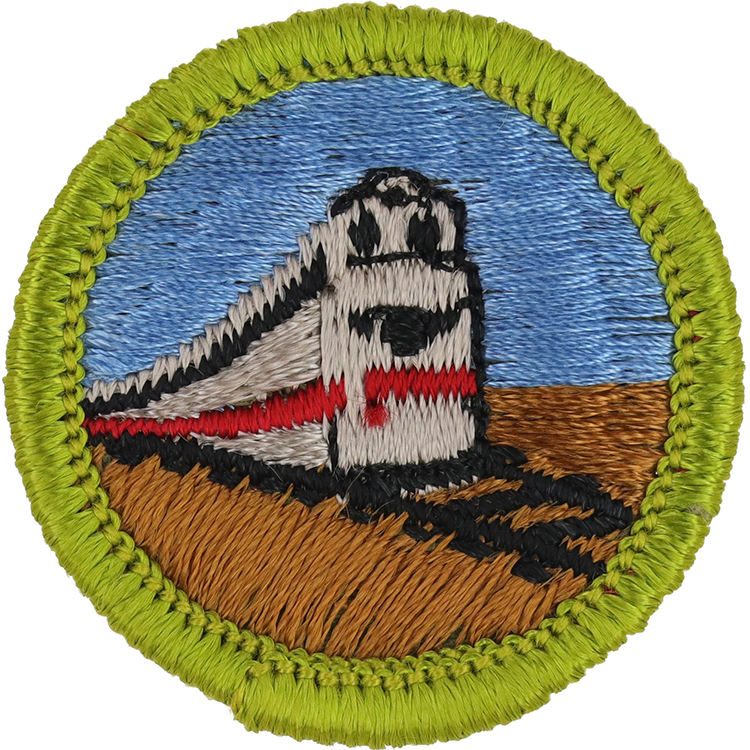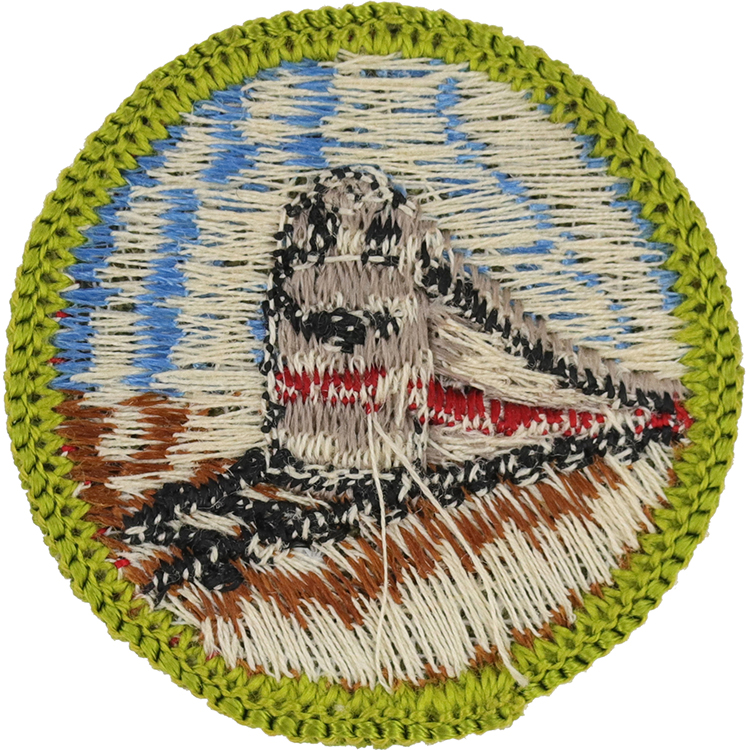
Fig. 1: Railro-G-Front
- Embroidery: Cotton thread
- Border: Merrowed

Fig. 2: Railro-G-Reverse
- Back: Starched cloth
Item Name: Railroading 1961 - 1972
Item ID: Railro-G
Collector Rating: 1
Requirements September 1961 until January 1969
1. Outline the major steps in the growth and development of the railroads in the United States and discuss the importance of the railroads to our daily life.
2. Name the railroads that serve your community and plan a trip by rail to a city at least 500 miles from your home. Obtain train information (timetable and other folders) from the railroad you would use that would give you the time of departure, the time of arrival, the name or number of the train, and the kind of service you would use.
3. Explain briefly how each of the three kinds of locomotives (steam, electric, and diesel) develops power.
4. Identify by model or picture six different types of railroad cars used in carrying people or products.
5. Name and explain briefly at least ten of the many railroad occupations. Tell who is in charge of a train when it is in operation.
6. Have a knowledge of signals used by trainmen. Demonstrate arm or lantern signals commonly used. Select one type of semaphore or light signal system and tell what its various signals mean. Explain the meaning of five train whistle signals. Describe an emergency method of signaling a train to stop.
7. Explain at least six rules of safety to observe aboard trains; on platforms; at crossings; and around bridges, yards, and tunnels.
8. Do any three of the following:
(a) Name at least four departments of a railroad company and briefly describe the function of each.
(b) Identify freight cars of at least ten different railroads by their symbols (sometimes called heralds or insignia).
(c) Plan and take a rail trip of at least 25 miles; purchase your own ticket and read the timetables and related footnotes correctly.
(d) Name which job interests you most in railroad work and give the reason.
(e) Know name, scale to foot, proportion, and track gauge for four standard model railroad gauges. Demonstrate proper method of cleaning and lubricating a model locomotive and other model equipment.
(f) Draw to scale the layout of your own model railroad or a layout that could be built in a suitable place in your home. Your layout must include at least a point-to-point or continuous loop road with a variety of routings, a turnaround, a terminal, a classification yard, and one or more sidings.
(g) Alone or with others, construct a model railroad layout. Lay track with realistic ties, ballast, and scenery. Make proper wire connections from power supply to track and accessories.
(h) Make an acceptable scale model or a locomotive with or without motive power or two pieces of rolling stock. (Kits may be used.)
(i) Draw scale plans and construct two model accessories, such as a station, bridge, trestle, tunnel, roundhouse, or turntable.
Requirements January 1969 until June 1972
1. Do any TWO of the following five projects:
(a) Know the name, scale, and track gauge for four standard model railroad gauges. Demonstrate the proper method of cleaning and lubricating a model locomotive and other model equipment.
(b) Draw to scale the layout of your own model railroad or a layout that could be built in a suitable place in your home. Your layout must include at least a point-to-point or continuous loop road with a variety of routings, a turnaround, a terminal, a classification yard, and one or more sidings.
(c) Alone or with others, construct a model railroad layout. Lay track with realistic ties, ballast, and scenery. Make proper wire connections from power supply to track and accessories.
(d) Make an acceptable scale model of a locomotive (with or without motive power) or two pieces of rolling stock. (Kits may be used.)
(e) Draw scale plans and construct two model accessories, such as a station, bridge, trestle tunnel, roundhouse, or turntable.
2. Do the following:
(a) Explain briefly how real electric and diesel locomotives develop power.
(b) Identify by model or picture six different types of railroad cars used to carry people or products.
(c) Have a knowledge of signals used by trainmen. Demonstrate arm or lantern signals commonly used. Select one type of semaphore or light signal system and tell what its various signals mean. Explain the meaning of five train whistle signals. Describe an emergency method of signaling a train to stop.
3. Do ONE of the following two projects:
(a) Name at least four departments of a railroad company and briefly describe the function of each.
(b) Name and explain briefly at least 10 of the many railroad occupations. Tell which job interests you most and give your reasons.
4. Explain at least six rules of safety to observe aboard trains; on platforms; at crossings; and around bridges, yards, and tunnels.
5. Do the following:
(a) Make a written plan for a trip by rail to a city at least 500 miles from your home. Obtain train information (timetable and other folders) from the railroad you select. From these folders list in your write-up the time of arrival, the name and number of the train, and the kind of service you desire to use.
(b) Name the railroads that serve your area and explain the procedure to be followed in arranging for the shipment of a carload of freight to a city at least 500 miles from your home.
Also, do ONE of the following:
(a) Plan and take a rail trip of at least 25 miles; purchase your own ticket and read the timetables and related footnotes correctly.
(b) Identify at least 10 different railroads by the symbols on the sides of freight cars.
6. Outline the major steps in the growth and development of the railroads in the United States and discuss the importance of the railroads to our daily life.



